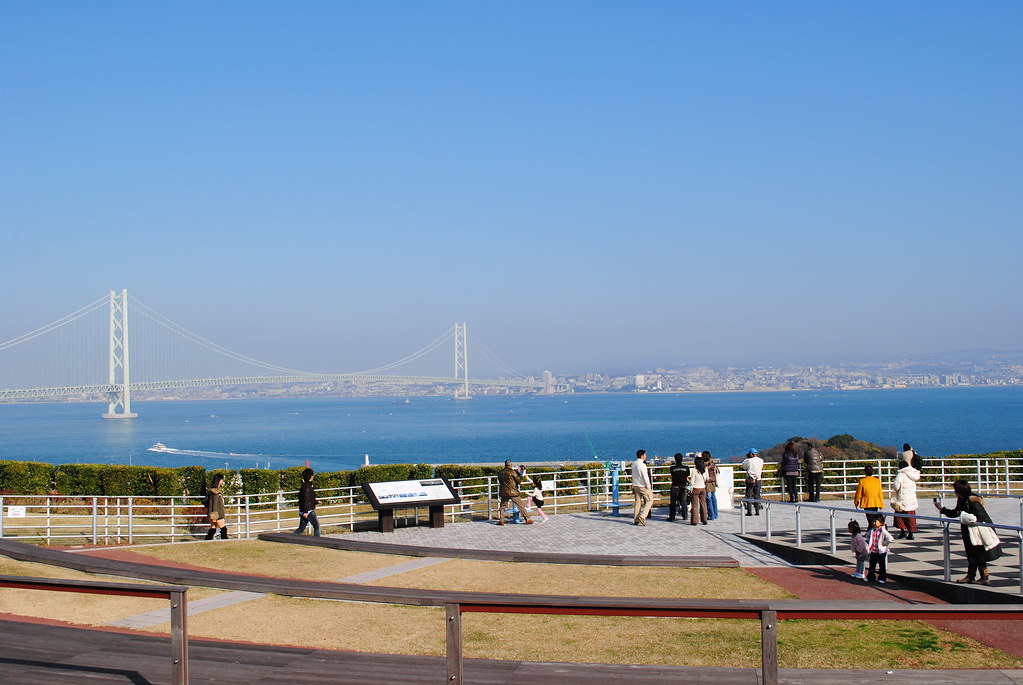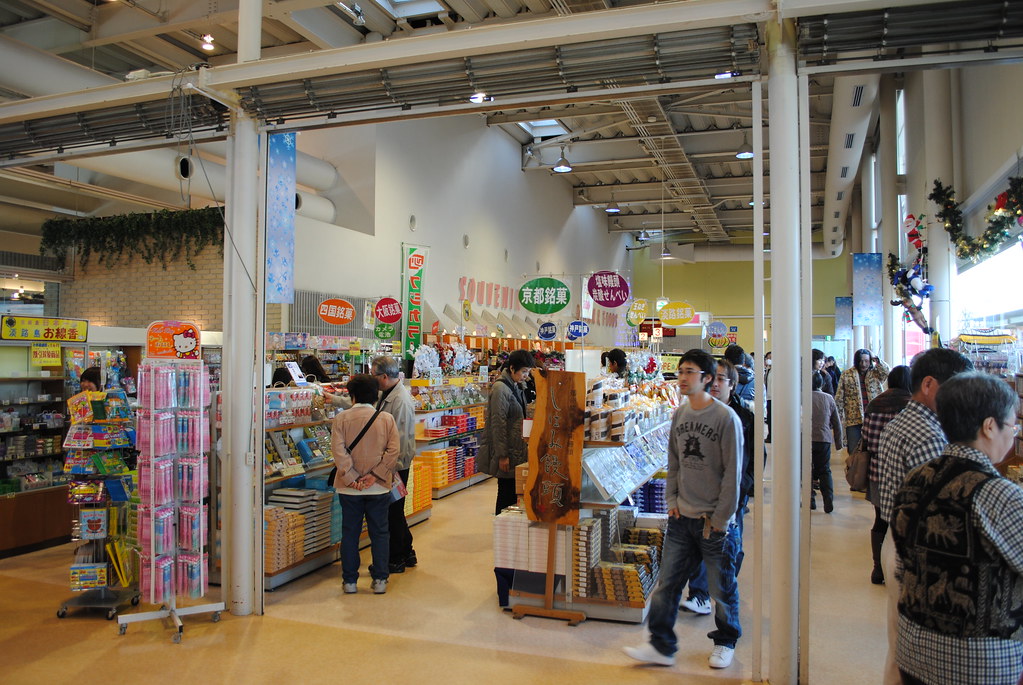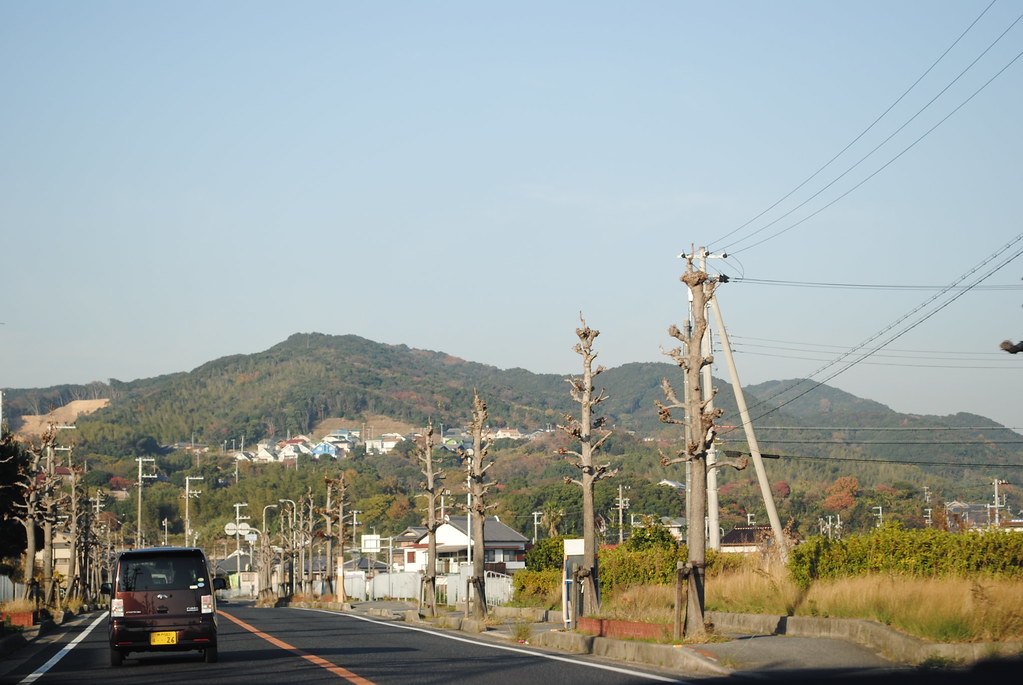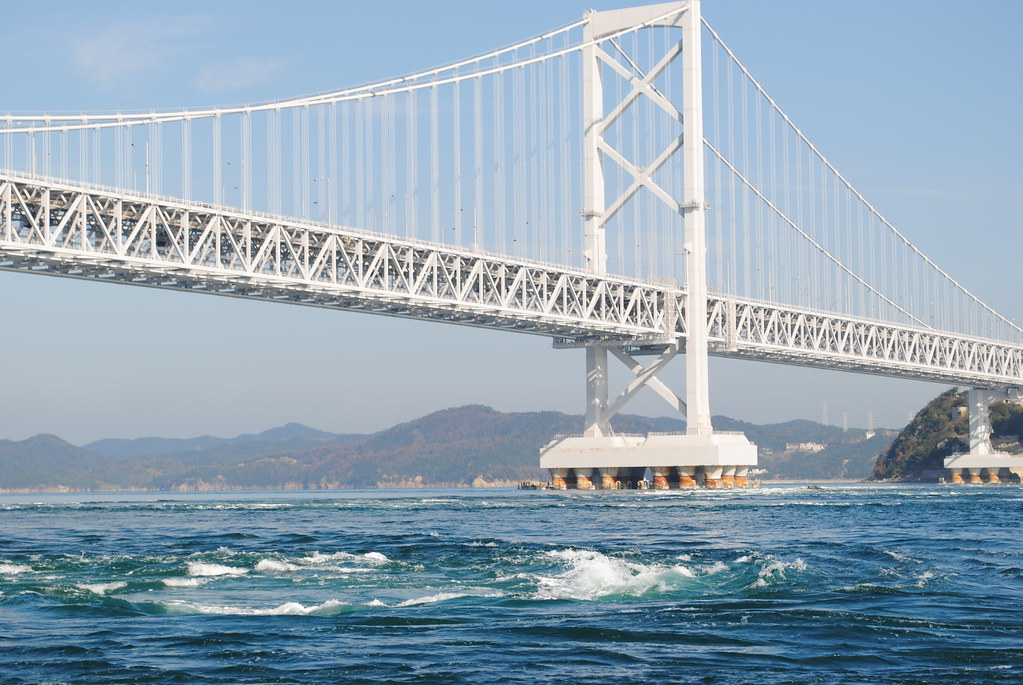Today we cross the bridge from 明石 (あかし - Akashi) to the small island on the other side of the strait. 淡路島, usually just known as 淡路 (あわじ - Awaji), is the southernmost part of 兵庫 (ひょうご - Hyogo), forming part of the long road over the bridges and down to 四国 (しこく - Shikoku). Many people only see it whipping past during their travels, but if you get off the highway and take the time to explore a little, I'm sure you'll find something to like. Let's hop off at the next exit and have a look around - there's more to it than just the expressway. In fact, if you believe the stories, it may well be the first part of Japan that was created.
While there's more to 淡路 than just the expressway, it does fulfill a very important purpose; the 明石海峡大橋 (あかしかいきょうおおはし - akashi kaikyou oohashi - Akashi Strait Bridge) is just the first part of a relatively recent toll road that runs all the way from 神戸 (こうべ - Kobe) deep into 四国. 淡路 takes its hosting duties very seriously as well - your first stop on the trip once you make it across the bridge will probably be what's known as 淡路ハイウェイオアシス (Awaji Highway Oasis), a rest stop servicing the huge volume of traffic commuting to and from the island. It offers similar views of the 明石海峡大橋 as those of the 明石 side - it looks just as impressive from either direction.
Rest stops like this one are extremely common in Japan, given the huge number of trucks and tour buses roaring around at any given time. They dot all of the routes between major destinations offering 24 hour shops, petrol, toilets, refreshments, souvenirs and in some cases fully equipped food halls. It's not very often you find one with a ferris wheel though! 淡路ハイウェイオアシス looks more like an airport terminal than a service station; with tourist information booths, coffee houses, dozens of 自動販売機 (じどうはんばいき - jidouhanbaiki - vending machines) and huge おみやげ (omiyage - souvenir) shops, it has enough to satisfy the hundreds of weary travellers stumbling out of its endless carpark at any given time.
As always, おみやげ are a big part of travel in Japan. 淡路 is best known for its たまねぎ (tamanegi - onions) of all things, which means you can pick up a variety of local おみやげ such as ためねぎせんべい (tamanegi senbei - onion crackers) and たまねぎスープ (tamanegi suupu - onion soup). While it's a rather depressing reason for it, 淡路 was originally known for たまねぎ because the soil was too poor and degraded to grow anything else properly! Nowadays, the soil is much improved so the たまねぎ have properly earned their reputation; they are delicious and extremely sweet and will probably be a part of every meal you eat in 淡路. I'm told that 淡路 beef is quite famous as well, so for a double dose of the local fare, you could head over to the food hall for some 牛丼 (ぎゅうどん - gyuudon - beef bowl) with plenty of たまねぎ. Of course, if beef and たまねぎ aren't your thing, you can find a host of other おみやげ and food, from fish products to chocolate to caramels.
Once you've had your fill of food, drinks and おみやげ, it'll be time to hit the road and continue your trip. 淡路 is notoriously hard to get around without a car, unfortunately - there are no trains to the island and buses are quite infrequent - not having your own transport will make getting where you're going very difficult. Nevertheless, it makes for very pretty road trips with lush mountains in the background, particularly during 春 (はる - haru - Spring) when fields of 水仙 (すいせん - suisen - narcissus) come into bloom across the whole southeast of the island. During 夏 (なつ - natsu - Summer), the beautiful beaches around the coast will probably be very tempting, skirted by tall pine trees and crowds of people escaping 神戸 and 大阪 (おおさか - Osaka) to cool off. If Japanese culture is more your thing, you might want to try and catch a 文楽 (ぶんらく - Bunraku - Japanese puppet theatre) performance; the region is very famous for them and I've heard that 淡路 is actually where 文楽 originated.
If you keep going all the way to the other end of 淡路 in the southwest, you can reach what's known as the 大鳴門橋 (おおなるときょう - oonaruto kyou - Oonaruto Bridge) that leads over to 四国 as promised. It's so named because it connects 淡路 to 鳴門 (なると - Naruto), a city in 徳島県 (とくしまけん - tokushimaken - Tokushima Prefecture). While it's not nearly as big as the 明石海峡大橋, it was completed over 35 years ago so it's still an impressive piece of engineering. The strait between 四国 and 淡路 is only about one kilometre wide, but even before the 大鳴門橋 was completed, it must have been considered an easy trip. In fact, the name "淡路" means "road to Awa", Awa being the old name for 徳島県. It seems that poor old 淡路 was branded a thoroughfare from the get-go!
Because the strait is so narrow, the tides move very quickly under the 大鳴門橋 and that, coupled with the rough and rocky sea floor, has some interesting effects. At certain times of the day, the rushing water forms into mini-waterfalls that drop over the rocks, churning up the water into foam. If the tides are just right, the swirling currents form into whirlpools that curl and splash along the sides of the bridge. These are known as the 渦潮鳴門 (うずしおなると - uzushio naruto - Naruto Whirlpools), a phenomenon unique to this part of Japan. They make the area a popular enough sightseeing spot that websites have been put up with tidal timetables months in advance. Dates with very high and low tides are marked in red and those are the ones people aim for - if you risk going at other times you may be unlucky enough not to see anything at all.
There are two ways to see the 渦潮鳴門 - you can get a boat or use a viewing platform to look through the bottom of the 大鳴門橋. Boats provide a better view and can range in size from massive tourist ships to small fishing boats; in either case you can get up close and personal. The viewing platform is accessible from the 徳島 side of the bridge as part of a museum just off the expressway. Unfortunately the bridge is very high up, so the best you can expect is a bird's eye view of the tides. They appear and disappear very erratically, so being able to chase them around in a boat is the best way to go if you want some good shots. As I said earlier in the year, the Naruto アニメ (anime) draws very heavily on the actual city of 鳴門 both through the name and the telltale 渦潮鳴門-like swirly patterns used throughout the series. In fact, the characters in the show even name the 大鳴門橋 after Naruto at one point (although in reality it was the other way around!).
淡路 isn't just nice tourist spots though - according to Japanese mythology, it's also where it all started. As the story goes, the god and goddess of creation took their spear and swirled its tip around in the ocean; when they pulled it out, the drops that fell off it created the islands of Japan. The first was known as "Onogoroshima", which is modern day 淡路. Unfortunately, the unfavourable growing conditions meant that people typically dreamed of making it to places like 大阪 and striking it rich; there wasn't much glory in living on the first island if you couldn't provide for yourself. Interestingly, things have come full circle and it's now the big city folk who come to 淡路 to get away from the hustle and bustle and enjoy the peace and quiet.
The story of Onogoroshima is not the only divine intervention 淡路 can lay claim to. As you turn around and head back towards the 明石海峡大橋, one of the last things you might see is a huge statue of 観音 (かんのん - Kannon), the goddess of mercy. She is possibly best known for having colossal statues built of her - another one is in 京都 (きょうと - Kyoto) for example - but as the tales go, she would fly in on a silver cloud and rescue people in need. As you've probably gathered, despite its grand roots 淡路 used to be quite a poverty-stricken part of Japan, so the poor and weak were the most common beneficiaries of the mercy of 観音. After a whole day on your feet seeing the sights and buying armfuls of おみやげ, you might end up feeling a bit poor and weak yourself. Keep an eye out for that silver cloud - maybe she'll give you a lift home.









No comments:
Post a Comment
If you have any questions or additions, I would love to hear from you. I may not know the answer, but I'll do my best to find out in any case! You can post anonymously if you like, but abusive/unintelligible/inappropriate comments will not be published.